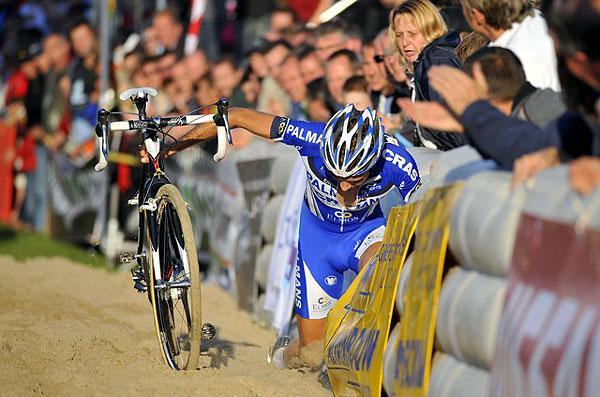Sand pit prohibition forces 'cross promoters to be creative
Organisers struggle to create interest

Due to a new UCI rule that prohibits the use of artificial sand pits in cyclo-cross races, race organizers have had to come up with creative new ideas to make courses challenging.
As one of the first races of the season, the organization of the Superprestige Series round in Ruddervoorde, Belgium was confronted with the issue. Usually the race features an L-shaped sand strip that created a spectacle for the fans and a challenge for the riders in this area that lacks natural topographical obstacles.
Brothers Wim and Geert Pyfferoen, the race organisers, came up with an inland solution to add interest: cobbles.
When asked how they came up with this solution Geert Pyfferoen couldn't quite recall the circumstances. "Probably after we had a couple of drinks," he joked. "I hope it will bring some spectacle to the race. It is a pity that we had to remove the sand strip."
Organisers aren't clear on whether existing playground sand pits in races like Eernegem would be allowed. Former world champion Paul Herijgers confirmed there was a problem. "The system isn't waterproof. In some races there is a swing and then sometimes it is allowed," Herijgers said.
"If a father goes to a race with his kid and he asks the kid where he wants to watch the race - in the meadow or at the sand pit - you're always going to end up at the sand pit because it is spectacular."
Belgian national coach Rudy De Bie wasn't expecting that the cobbles would cause damage in the race. "They're better laid than those on my driveway," De Bie said. "It's too bad Ruddervoorde wasn't allowed to keep the sand because it was safe and spectacular," he added.
Get The Leadout Newsletter
The latest race content, interviews, features, reviews and expert buying guides, direct to your inbox!
UCI's Peter Van den Abeele explained why the decision was taken. "This is a interference on demand of the riders. Erwin Vervecken, who represents the riders at the UCI, asked the riders what they thought about it and after debating it we took the decision," Van den Abeele said to Het Laatste Nieuws.
Vervecken defended the decision. "A sand 'cross is a sand 'cross, and a mud 'cross is a mud 'cross. Maybe in Ruddervoorde the sand pit fits in when it was dry but you've got to draw the line somewhere. The sand became some sort of hype, just like the barriers ten years ago; that can't be the goal of it," Vervecken said.
Top cyclo-cross riders Niels Albert, Sven Nys and Bart Wellens were suprised by this news. "I wasn't asked about it," Albert said, "so it seems that the opinion of the world champion doesn't matter. There's nothing wrong with the sand pit in Ruddervoorde. Then again, the sand that appeared on the course of the world championships in Hooglede 2007 and also Tabor last year was useless, but that doesn't mean you have to generalize the decision," Albert commented.
Vervecken admitted he didn't ask the question directly to Albert. "But I know that some sand strips haven't been popular for several years now. Suddenly the opinions are more divided. Maybe we should allow exceptions," Vervecken said, but Van den Abeele didn't like that idea at all.
"Where do you draw the line? In Ruddervoorde it's OK, but not in Diegem? It's impossible to figure out where it is functional or not. No, it's like that and it stays like that," Van den Abeele said.
In the end the cobbles in Ruddervoorde weren't decisive at all and surely the organizers will be keen to get the sand pit back in their course.
"Organizers will always find a solution to create spectacle," Herijgers said. In Loenhout the organizers of the Azencross added what is called a washboard, wich is often seen in motocross, and of course creativity doesn't have any limits. "I wonder how long it will take before we see zones with a real mud bath," Herijgers said, seemingly not even joking.